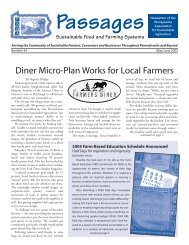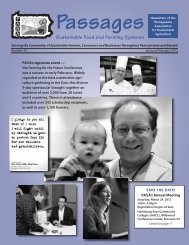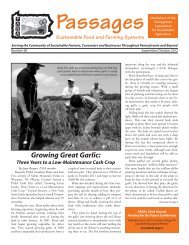Farmer Profile Tussock Sedge Farm Henry & Charlotte ... - PASA
Farmer Profile Tussock Sedge Farm Henry & Charlotte ... - PASA
Farmer Profile Tussock Sedge Farm Henry & Charlotte ... - PASA
You also want an ePaper? Increase the reach of your titles
YUMPU automatically turns print PDFs into web optimized ePapers that Google loves.
<strong><strong>Farm</strong>er</strong> <strong>Profile</strong><br />
<strong>Tussock</strong> <strong>Sedge</strong> <strong>Farm</strong><br />
<strong>Henry</strong> & <strong>Charlotte</strong> Rosenberger<br />
By Michelle Isham, <strong>PASA</strong> Member<br />
For <strong>Henry</strong> Rosenberger simplicity is the key to successful farming. The<br />
former food distributor and his wife, <strong>Charlotte</strong>, bought a farm in Blooming<br />
Glen (Bucks Co.) in 1991. They lived on the property but rented the land<br />
out to another farmer. After watching his land being farmed, Rosenberger<br />
found himself interested in agriculture. So when he sold his business in<br />
1998, instead of renting out the land he farmed it himself.<br />
“I enjoyed watching the farming so much that I wanted to try it,” he said.<br />
Rosenberger started out in traditional farming with corn and soybeans and<br />
quickly learned about the unique perils of agriculture. Environmental factors<br />
from wildlife to weather diminished his harvest. Additionally, Rosenberger<br />
found himself troubled by his reliance on his seed and fertilizer suppliers.<br />
“Between the ground hogs and the deer you can pretty much loose a<br />
soybean crop,” he said.<br />
In 2005 he decided crop farming wasn’t working and sold his equipment.<br />
With the encouragement of his family, he switched from crops to cattle.<br />
“That’s when I fell in love with what I was doing and left the frustration<br />
behind,” Rosenberger said. Today <strong>Tussock</strong> <strong>Sedge</strong> <strong>Farm</strong> has 100 cow/calf<br />
pairs in the herd and 100 steers finishing. The farm has 500 acres of hay<br />
and pastures.<br />
“Making 500 acres of hay and managing grass and pastures and fencing<br />
it’s a big job but I love it,” he said.<br />
Rosenberger said that prior to changing over to cattle he felt as though he<br />
was working for his seed and fertilizer suppliers. “I admire the people who<br />
can do it but I don’t think it’s long term sustainable because it’s too heavily<br />
dependent on the seed and chemical companies,” he said.<br />
Rosenberger said that he learned the best way to be sustainable and make<br />
money in the cattle business is to have as little equipment as possible. He<br />
purchased smaller equipment and is considering going to intensive grazing.
The Rosenbergers also sell their beef directly to customers through their<br />
website, www.tussocksedgefarm.com. Rosenberger advises other farmers<br />
to keep their operations as simple as possible.<br />
“I looked at hay cutters and choppers and I began to realize that all that is<br />
just money out of your pocket,” he said.<br />
<strong>Tussock</strong> <strong>Sedge</strong> <strong>Farm</strong> is about to simplify even further by changing from<br />
grain finished beef to grass finished beef, eliminating the need for grain<br />
from an outside supplier. Rosenberger was very pleased with the quality of<br />
the beef they were producing on grain, but found that consumer demand<br />
was trending toward grass-finished beef. At first, Rosenberger was<br />
skeptical that he could get the level taste and marbling he wanted from<br />
entirely grass-fed beef. After experimenting with a few heifers, he found he<br />
could.<br />
“I guess I was the biggest doubter in terms of whether I could get the<br />
quality I want so did a test run of six heifers … I had to convince myself,” he<br />
said.<br />
Of the total acreage, about 440 acres of <strong>Tussock</strong> <strong>Sedge</strong> <strong>Farm</strong> are<br />
permanently preserved as open space through the Bucks Country<br />
<strong>Farm</strong>land Preservation program. Putting land in the farmland preservation<br />
program means it’s committed to agriculture in perpetuity. This means it will<br />
be used in some form of agriculture –from fish farms to hay – in perpetuity.<br />
“It’s a bit of sacrifice because you’re not getting market value per acre but<br />
from the standpoint of peace of mind and beauty it gives a lot of<br />
satisfaction,” said Rosenberger.<br />
Rosenberger and his wife are continuing to work toward improving their<br />
land. They have built two dams to restore 26 acres of wetlands on the<br />
property. They also have planted 450 trees and native grasses.<br />
“The birds and the tweeters and the frogs are coming back,” said<br />
Rosenberger. “It’s been four years since we last used RoundUp. The<br />
peepers are coming back. We heard them again for first time last year.”<br />
Rosenberger credits county and state farming programs and organizations<br />
like <strong>PASA</strong> for helping him balance farm profitability with sustainability. “I<br />
think Pennsylvania, especially <strong>PASA</strong>, has been particularly helpful to me
where you learn from people who are doing things in a sustainable way,”<br />
he said.<br />
For more information contact <strong>Tussock</strong> <strong>Sedge</strong> <strong>Farm</strong> at 1239 Route 113 Box<br />
59, Blooming Glen, PA 18911, email henryrosenberger@gmail.com, 215-<br />
257-4868 or visit www.tussocksedgefarm.com.<br />
Interview with <strong>Charlotte</strong> & <strong>Henry</strong> Rosenberger<br />
What do you see as some of the critical issues facing agriculture<br />
today<br />
The greatest issue facing agriculture is the question of whether it can be<br />
sustained on the base of chemical dependency that we have placed most<br />
of the production of output today and the cost we employ getting it to<br />
market. We have been led by cheap fuel into chemical dependent<br />
production and specialized large scale production requiring 1,500 miles of<br />
transport for nearly all food consumed in the U.S. Agriculture is not<br />
sustainable done in this manner over time. The second issue I feel strongly<br />
about is the challenge of individual farmers to sell their production into a<br />
market driven by big business and subsidized by government, which<br />
destroys opportunity for the small farmer to grow here in the U.S. And it is a<br />
disincentive for small producers in developing countries affected by our<br />
(U.S.) cheap, subsidized exports entering their markets. We need to<br />
develop geographic sourced product and regionalize our food sources and<br />
reduce transit cost and reduce environmental impact.<br />
What is unique about our farm<br />
Our farm is made up of several farms scattered around the village of<br />
Blooming Glen forming a green buffer, very European like; 73 acres are in<br />
forest and wetlands. All the rest of the farm is grassland paddock for<br />
rotational grazing, and hayfields. We have placed conservation easements<br />
upon 425 acres and doing wetland restoration on 26 acres. Our focus now<br />
is grass fed beef with an eighty five herd cow calf operation and a transition<br />
to all grass finished beef which we direct market. We formed a partnership<br />
with two organic farmers to rent and operate a CSA on 15 acres of our land<br />
offering 200 memberships to local residents and also sell produce at some<br />
markets. The entire farm is on “chemical withdrawal” now using all natural<br />
manure, compost and lime. It is challenging to make a profit, which is the<br />
core of sustainablility, but we continue to learn and grow and feel good<br />
about what we do.
How has the operation evolved<br />
We began farming after careers in food warehousing and trucking (<strong>Henry</strong>)<br />
and nursing mothering and counseling (<strong>Charlotte</strong>) first in traditional crop<br />
farming with cow calf. After ten years and lots of losses it was apparent<br />
change had to happen and our children helped us focus on what was<br />
possible without hired help and reduced overhead. We sold the combine,<br />
leased the grain bins and with Natural Resource Conservation Service<br />
(NRCS) help, through EQIP, transitioned into fenced pastures and<br />
hayfields. The past four years have taught us a lot about what don’t work<br />
and what does. Feeding cows on grass is all about growing good grass<br />
mixes and learning how to make and store hay for the winter at least cost.<br />
We have learned that growing great beef can be done on grass.<br />
Why did you join <strong>PASA</strong><br />
We joined <strong>PASA</strong> because we learn from others and network to learn a lot<br />
about agriculture, which isn’t taught at our Ag Schools. Some of the<br />
techniques and methods of farming have been lost in the swirl of chemical<br />
driven agriculture. We have to relearn agriculture and understand what<br />
systems are sustainable. I have found <strong>PASA</strong> to be my source of mentors<br />
and information in this capacity and was chagrined at the <strong>PASA</strong> conference<br />
on grass fed beef to find no Penn State faculty present, supportive of the<br />
program. I believe that big business interests control the focus of our Ag<br />
Education. We need <strong>PASA</strong> even more to tell the ”other side of the story."







